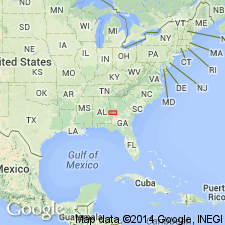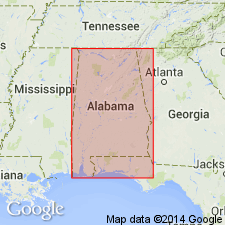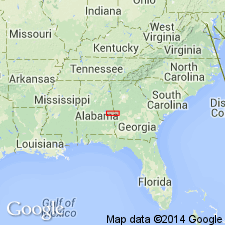
- Usage in publication:
-
- Halawaka Schist
- Modifications:
-
- First used
- AAPG geologic province:
-
- Piedmont-Blue Ridge province
Summary:
Name apparently attributed to unpublished report by Bentley, Neathery, and Scott on Lee Co., east-central AL. In AL, Pine Mountain Group consists of Hollis Quartzite, Chewacla Marble and schist, Manchester Formation, and, in authors' opinion, Halawaka Schist. Appears to be same unit as Sparks Schist in GA. Included with Pine Mountain Group instead of with Wacoochee Group (as shown in unpublished Lee Co. report) because of detailed mapping and geochronological investigations by other workers. Felsic gneisses, "granites", and augen gneisses and charnockites generally assigned to Wacoochee Group in Pine Mountain window represent a variably retrograded and deformed granulite-facies basement complex of Grenville age; basement complex now includes Jeff Davis "Granite, charnockite series rocks, Woodland Gneiss, Cunningham "Granite," Wacoochee Gneiss, and Whatley Mill Gneiss. Basement is unconformably overlain by younger, stratigraphically coherent metasedimentary rocks of Pine Mountain Group. This interpretation requires that aluminous Halawaka Schist, previously included with Wacoochee rocks in AL by Bentley, Neathery, and Scott (unpub. report on Lee Co.), be assigned to Pine Mountain Group. For simplicity, Halawaka should be dropped in favor of the term Sparks Schist for use in Pine Mountain Group [name is not abandoned here].
Source: GNU records (USGS DDS-6; Reston GNULEX).

- Usage in publication:
-
- Halawaka Schist
- Modifications:
-
- Overview
- AAPG geologic province:
-
- Piedmont-Blue Ridge province
Summary:
Used as Halawaka Schist of Wacoochee Complex. Type locality given as exposures along Salem-Halawaka Rd through secs. 13, 24, and 26 of T19N, R28E, Lee Co., east-central AL. Typical exposures may also be seen along backwaters of Chattahoochee River, along Little Uchee and Wacoochee Creeks, and in immediate area of Halawaka. Described as an intermixed sequence of feldspathic muscovite-biotite schist and quartz-diorite gneiss and augen gneiss and lenses of muscovite-graphite schist and thin, irregular amphibolite units. Locally includes numerous small, muscovite-rich pegmatites.
Source: GNU records (USGS DDS-6; Reston GNULEX).

- Usage in publication:
-
- Halawaka Schist*
- Modifications:
-
- Overview
- AAPG geologic province:
-
- Piedmont-Blue Ridge province
Summary:
In the Pine Mountain belt (Pine Mountain window), Middle Proterozoic basement rocks are represented by Wacoochee Complex and its components, Whatley Mill Gneiss and Halawaka Schist. Overlying cover sequence is represented by Pine Mountain Group, which consists of (ascending) Hollis Quartzite, Manchester Schist, and Chewacla Marble (Bentley and Neathery, 1970; Sears and others, 1981; and Crickmay, 1952). Report includes geologic sketch map.
Source: GNU records (USGS DDS-6; Reston GNULEX).
For more information, please contact Nancy Stamm, Geologic Names Committee Secretary.
Asterisk (*) indicates published by U.S. Geological Survey authors.
"No current usage" (†) implies that a name has been abandoned or has fallen into disuse. Former usage and, if known, replacement name given in parentheses ( ).
Slash (/) indicates name conflicts with nomenclatural guidelines (CSN, 1933; ACSN, 1961, 1970; NACSN, 1983, 2005, 2021). May be explained within brackets ([ ]).

